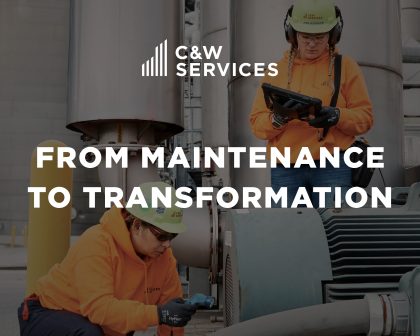We know that you and your facilities team are constantly looking for new ways to improve efficiency and reduce costs. But given the current rate of innovation in the facilities services industry, it can be difficult to stay informed about all of the latest innovations and best practices. That’s why we recently hosted a webinar in collaboration with Plant Engineering Magazine that delved deep into one of the industry’s hottest topics: when and how to best use predictive maintenance to maximize your cost and ROI.
We received a number of insightful questions during the webinar — more than we could answer in the webcast. Our team of subject-matter experts has answered them below. If you have a question about the future of facilities, please don’t hesitate to get in touch.
What key performance indicators (KPIs) should we consider to track PdM effectiveness?
You should measure the number of “find it first” or detected anomalies that can be corrected. Overall, the measure should reflect reliability improvement achieved by the reduction in unexpected failures. Monitoring can provide awareness of an impending event, which counts as a value-add.
What are the long and short-term costs, and savings achievable from putting in place a regular PdM process?
There are two short-term benefits: immediate labor and safety exposure reduction, and the ability to identify and coordinate the repair of struggling units. The long-term benefit is the overall reliability value (less production downtime) and the net extending of unit life (adding years to equipment duration).
How long does it take to set up an IOT-enabled PdM program?
It is very straightforward to add sensors and connect them to an existing communication network (LAN, etc). It maybe takes a week or so. Having to work through firewalls, security challenges, or installing a network (in the case of cooling towers, generators, etc) can extend the project by a few weeks. One approach is to do a pilot program on a simple solution before starting on a large project.
By how many percentage points will predictive maintenance improve downtime?
That depends on your current state and your knowledge of your network. What you measure with predictive maintenance is the ability to predict an event, not a prevention of that event.
Does predictive maintenance work by AI or statistics analysis?
Most alarms work by high or low limits. More intelligent systems look at patterns or complex data. AI or machine learning is now becoming much more common. AI is dependent on a time period to learn and usually a reference library of historical observations. I am hoping in the next year or two, we will be able to have a fully AI detection capability out of the box.
How can you identify when predictive maintenance is being done too often? Is it cost effective to have a third party evaluation of the PdM system we use?
Predictive Maintenance is being done too often when the cost of executing/analyzing exceeds the benefit demonstrated. Refer to the 6:1 rule based on the ALUMAX study, which states that PM inspections should reveal some type of corrective work that should be completed on an asset on average every 6 times it is accomplished.
I’d like to use IOT to gather predictive maintenance data, but my company policy doesn’t allow data transmission. How have you been able to overcome such restrictions?
This should be addressed upfront in a collaborative way. Explain that predictive maintenance is a great technology that improves the monitoring of critical systems, but requires IT support to provide a practical and effective communication framework.
What is your opinion regarding on-site portable data collection versus permanently installed continuous monitoring equipment? Will individually collected data eventually be replaced by wireless sensors?
Continuous or semi-continuous monitoring is required for condition-based value. The portable readings would be required with enough frequency and “consistently measured the same” process. Variability in the separate measures is as impacting as the frequency.
Will the process of data review negatively impact downtime?
Data review should not negatively impact downtime. The review should occur as a post-mortem after return to service or alongside the return to service effort. Remember the productivity of the equipment is key. Redundant systems should maintain productivity while you “investigate.”
Get inspired and read more about how we’re leveraging new innovative technologies to deliver a broad portfolio of services, develop and empower our people, and define a new status quo.
Let’s connect about how our highly engaged team can help you.






